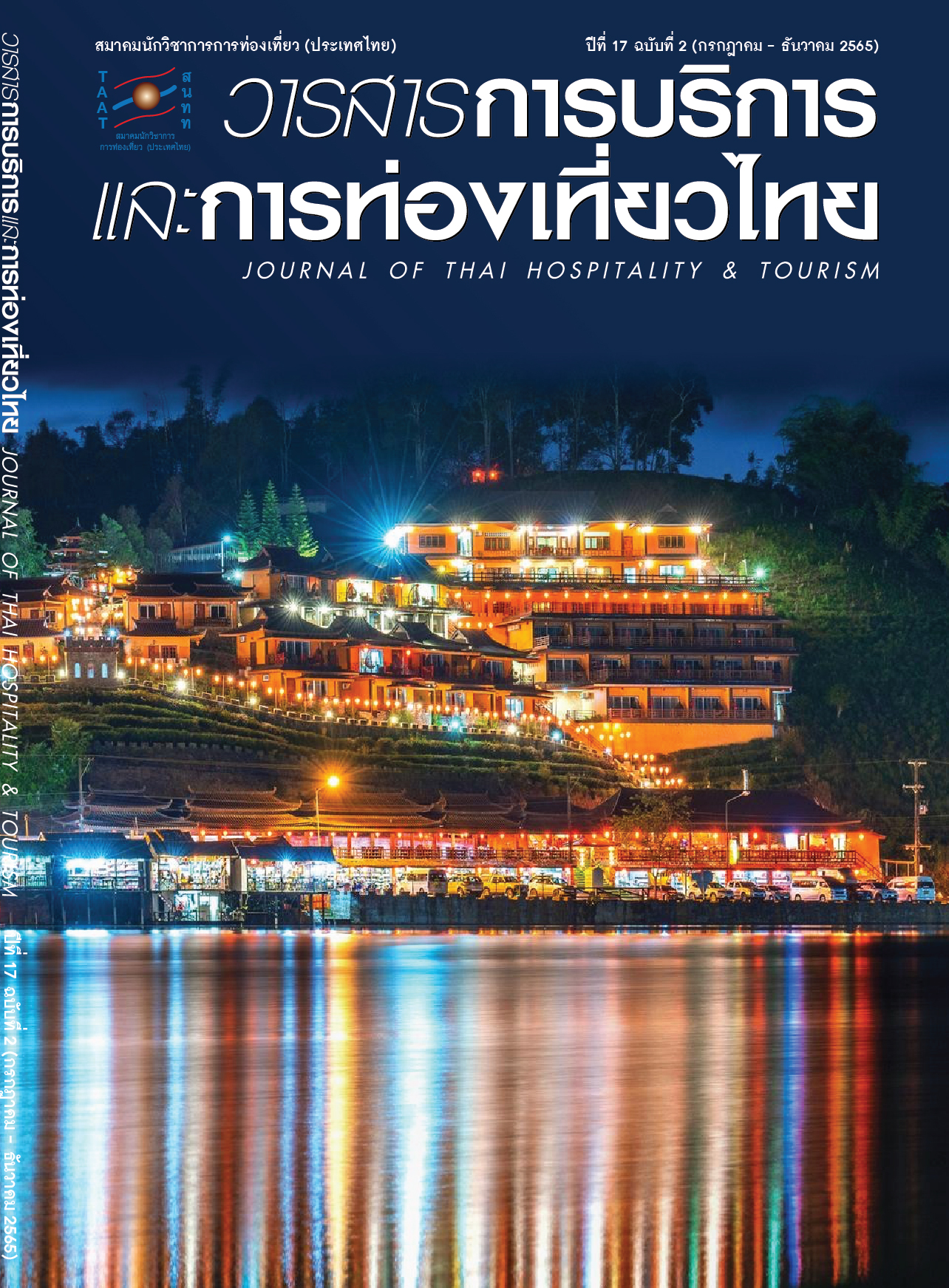Carrying Capacity of Mae Wang Tourism Sites, Chiang Mai Province
Main Article Content
Abstract
The research aims to study about the tourist carrying capacity of Mae Wang tourism in the Chiang Mai province. The sampling was divided into 2 clusters, including 400 tourists from accidental sampling with the questionnaires as a tool in data collection, and 25 respondents from purposive sampling were selected for in-depth interviews, including the representatives of entrepreneurs, governments, community leaders, and members. The data was analyzed using the physical carrying capacity (PCC) and facility carrying capacity (FCC) of Mae Wang tourism.
The findings showed that the physical carrying capacity of Mae Wang tourism is not higher than the real carrying capacity except that the waterfall and rafting spots on vacation are almost fully loaded for their land carrying capacity. The facility carrying capacity at Mae Wang tourism is overloaded, which could be a serious threat that urgently needs a solution to figure out the guidelines regarding 1) physical carrying capacity or land use at the waterfall; 2) water consumption at the Mae Wang River and Chiang Mai Royal Agricultural Research Center (Khun Wang); 3) waste management at the Mae Wang River; 4) transportation and parking places at the Mae Wang River and Chiang Mai Royal Agricultural Research Center (Khun Wang); 5) lavatory at the Mae Wang River and Chiang Mai Royal Agricultural Research Center (Khun Wang); 6) restaurants at the Chiang Mai Royal Agricultural Research Center (Khun Wang); and 7) accommodation and campgrounds at the Chiang Mai Royal Agricultural Research Center (Khun Wang).
Article Details

This work is licensed under a Creative Commons Attribution-NonCommercial-NoDerivatives 4.0 International License.
References
Chatchakul, N. (2012). Tourism Industry. Bangkok : Chulalongkorn University Press.
Choochat, C. (2001). An Ecotourism Model for Wang River Area. Chiang Mai : Thailand Research Fund.
Choochat, C. (2001). Tourism Industry. Chiang Mai: Lanna Printing.
Cochran, W. G. (1963). Sampling Technique. New York : John Wiley and Sons.
Emphandhu, D. (2014). Recreation Carrying Capacity : RCC. Retrieved from http://office.dpt.go.th/esp/images/stories/pdf/G_plan4/rcc_2557.pdf
Emphandhu, D. et al. (2005). The Caring Capacity of Khao Laem Ya – Mu Koh Samet National Park, Rayong Province. Faculty of Forestry, Kasetsart University.
Fiscal Policy Office (FPO). (2018). Economic and Fiscal Report : December and Quarter 4, 2019. Retrieved from https://gnews.apps.go.th/news?news=34718
Jittangwattana, B. (2005). Tourism Industry. Bangkok : Press and Design.
Meesawatdikul, W. (2009). Community Based Tourism Strategies Management of Baan Sobwin Tourism Club Moo.9, Maewin Sub-district, Mae Wang District, Chiang Mai Province. Chiang Mai: the Thailand Research Fund.
Phosittiphan, T. (2011). The National Park Carrying Capacity for Sustainable Tourism. FEU Academic Review, 5(1), 46–52.
Sangchumnong, A. (2018). Challenges of Cultural Heritage Communities to Sustainable Tourism Destination Development. Journal of Cultural Approach, 19(36), 82–91.
Songpornwanich, S. et al. (2014). The Community Tourism Carrying Capacity Guidelines. Bangkok : the Thailand Research Fund.
Sowman, M. R. (1987). A Procedure for Assessing Recreational Carrying Capacity of Coastal Resort Areas. Landscape and Urban Planning, 14, 331–334.
Sangchumnong, S. (2010). Model Development for Standard Quality of Ecotourism: A Case Study of the Center of Conservation of the Saltwater Forest, Klong Kon, Samut Songkhram Province. Research and Development Journal, 2(1), 60–69.
Vilailert, N. (2006). The Satisfaction of Thai Tourists toward Tourism in Phu Foilom Ecotourism Project of Udon Thani Province. Faculty of Science, Srinakharinwirot University.
World Tourism Organization (UNWTO). (1981). Saturation of Tourist Destinations : Report of the Secretary General. Madrid, Spain.
Yukel, A. & Yukel, F. (2002). Measurement of Tourist Satisfaction with Restaurant Services : A Segment Based Approach. Journal of Vacation Marketing, 9(1), 52–68.


